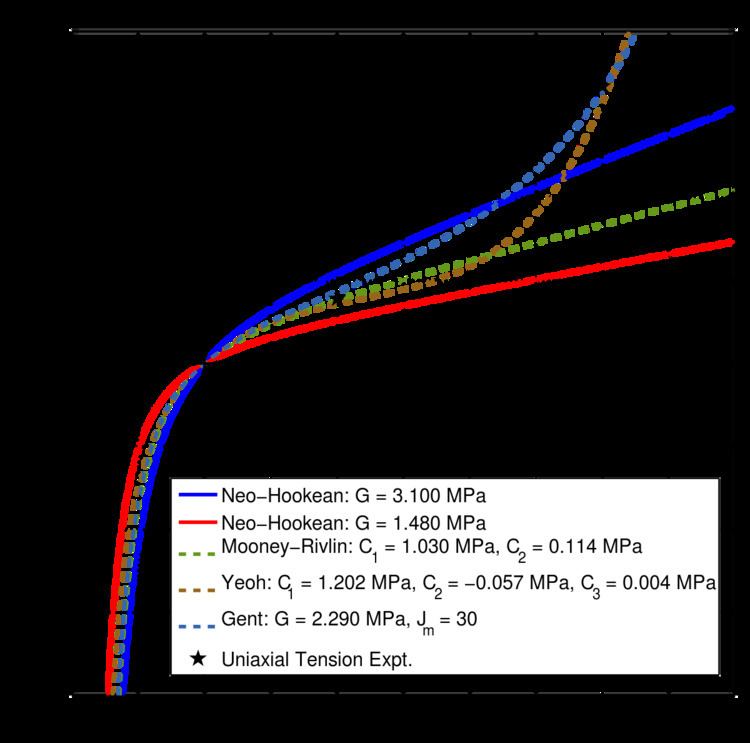 | ||
A hyperelastic or Green elastic material is a type of constitutive model for ideally elastic material for which the stress-strain relationship derives from a strain energy density function. The hyperelastic material is a special case of a Cauchy elastic material.
Contents
- Saint VenantKirchhoff model
- Classification of hyperelastic material models
- First PiolaKirchhoff stress
- Second PiolaKirchhoff stress
- Cauchy stress
- Incompressible hyperelastic materials
- Compressible isotropic hyperelastic materials
- Incompressible isotropic hyperelastic materials
- Consistency with linear elasticity
- Consistency conditions for isotropic hyperelastic models
- Consistency conditions for incompressible I 1 displaystyle I1 based rubber materials
- References
For many materials, linear elastic models do not accurately describe the observed material behaviour. The most common example of this kind of material is rubber, whose stress-strain relationship can be defined as non-linearly elastic, isotropic, incompressible and generally independent of strain rate. Hyperelasticity provides a means of modeling the stress-strain behavior of such materials. The behavior of unfilled, vulcanized elastomers often conforms closely to the hyperelastic ideal. Filled elastomers and biological tissues are also often modeled via the hyperelastic idealization.
Ronald Rivlin and Melvin Mooney developed the first hyperelastic models, the Neo-Hookean and Mooney–Rivlin solids. Many other hyperelastic models have since been developed. Other widely used hyperelastic material models include the Ogden model and the Arruda–Boyce model.
Saint Venant–Kirchhoff model
The simplest hyperelastic material model is the Saint Venant–Kirchhoff model which is just an extension of the linear elastic material model to the nonlinear regime. This model has the form
where
The strain-energy density function for the St. Venant–Kirchhoff model is
and the second Piola–Kirchhoff stress can be derived from the relation
Classification of hyperelastic material models
Hyperelastic material models can be classified as:
1) phenomenological descriptions of observed behavior
2) mechanistic models deriving from arguments about underlying structure of the material
3) hybrids of phenomenological and mechanistic models
Generally, a hyperelastic model should satisfy the Drucker stability criterion. Some hyperelastic models satisfy the Valanis-Landel hypothesis which states that the strain energy function can be separated into the sum of separate functions of the principal stretches
First Piola–Kirchhoff stress
If
where
In terms of the right Cauchy–Green deformation tensor (
Second Piola–Kirchhoff stress
If
In terms of the Lagrangian Green strain
In terms of the right Cauchy–Green deformation tensor
The above relation is also known as the Doyle-Ericksen formula in the material configuration.
Cauchy stress
Similarly, the Cauchy stress is given by
In terms of the Lagrangian Green strain
In terms of the right Cauchy–Green deformation tensor
The above expressions are valid even for anisotropic media (in which case, the potential function is understood to depend implicitly on reference directional quantities such as initial fiber orientations). In the special case of isotropy, the Cauchy stress can be expressed in terms of the left Cauchy-Green deformation tensor as follows:
Incompressible hyperelastic materials
For an incompressible material
where the hydrostatic pressure
This stress tensor can subsequently be converted into any of the other conventional stress tensors, such as the Cauchy Stress tensor which is given by
Compressible isotropic hyperelastic materials
For isotropic hyperelastic materials, the Cauchy stress can be expressed in terms of the invariants of the left Cauchy–Green deformation tensor (or right Cauchy–Green deformation tensor). If the strain energy density function is
(See the page on the left Cauchy–Green deformation tensor for the definitions of these symbols).
Incompressible isotropic hyperelastic materials
For incompressible isotropic hyperelastic materials, the strain energy density function is
where
If in addition
If
Consistency with linear elasticity
Consistency with linear elasticity is often used to determine some of the parameters of hyperelastic material models. These consistency conditions can be found by comparing Hooke's law with linearized hyperelasticity at small strains.
Consistency conditions for isotropic hyperelastic models
For isotropic hyperelastic materials to be consistent with isotropic linear elasticity, the stress-strain relation should have the following form in the infinitesimal strain limit:
where
For an incompressible material
For any strain energy density function
If the material is incompressible, then the above conditions may be expressed in the following form.
These conditions can be used to find relations between the parameters of a given hyperelastic model and shear and bulk moduli.
Consistency conditions for incompressible I 1 {displaystyle I_{1}} based rubber materials
Many elastomers are modeled adequately by a strain energy density function that depends only on
The second consistency condition above can be derived by noting that
These relations can then be substituted into the consistency condition for isotropic incompressible hyperelastic materials.
